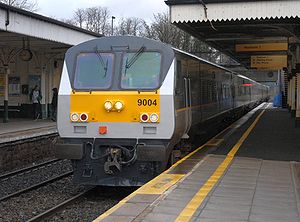- Dublin–Belfast railway line
-
The Dublin-Belfast main line is a major international railway route in Ireland that connects Dublin Connolly station in the Republic of Ireland and Belfast Central station in Northern Ireland.
Contents
History
The railway line was built by three separate companies. In 1837 the Ulster Railway began building a railway line between Belfast and Lisburn, which was extended in stages to Portadown in 1842 and as far as Clones by 1863. The Dublin and Drogheda Railway (D&D) built the line between Dublin and Drogheda. The Dublin and Belfast Junction Railway (D&B Jct) linked the Dublin and Drogheda with the Ulster Railway at Portadown. The D&D and the D&B Jct merged in 1875 to form the Northern Railway of Ireland. In 1876 this new company merged with the Ulster Railway and the Irish North Western Railway, forming the Great Northern Railway (Ireland) (GNRI).
The partition of Ireland in 1922 created an international border between Newry and Dundalk, which caused lengthy delays as trains were required to stop at stations on either side of the border for customs examinations. This disruption was eased in 1947 with the opening of facilities for customs checks at Amiens Street station and Great Victoria Street station.
At the same time, the GNRI made its Belfast-Dublin services non-stop with the launch of the Enterprise Express. The GNRI was nationalised by the governments of the Republic of Ireland and Northern Ireland in 1953 as the Great Northern Railway Board, but in 1958 this was split between the Ulster Transport Authority and Córas Iompair Éireann. This led to a running down of rail services in Northern Ireland, with the main line to Belfast closed in 1965.[citation needed] The newly formed Northern Ireland Railways reopened it in 1969 and bought new locomotives and rolling stock to restore the Belfast-Dublin Enterprise service as well as new diesel multiple units for local services.
Upgrades
In recent years, the government of the Republic of Ireland has developed a National Development Plan, which has seen major investment in infrastructure. Almost the entire railway network, including the Belfast-Dublin line as far as the border, has been upgraded to Continuous Welded Rail, while signalling is controlled using the Centralised Traffic Control system located at Dublin Connolly station. In addition, in 1997, a set of new De Dietrich Stock coaches were purchased jointly by Northern Ireland Railways and Iarnród Éireann to operate a revamped Enterprise service along with the new Class 201 locomotives.
Services
In addition to the inter-city service between Belfast and Dublin, both NIR and IE operate local services along the route. NIR operates local services along the northern half of the line (the Belfast-Newry Line) between Belfast and Lisburn, Portadown and Newry, while IE operates its Commuter services between Dublin and Dundalk as part of the Dublin Suburban Rail network. In addition, the line between Dublin Connolly and Malahide is electrified and forms part of the Trans-Dublin DART network.
Simulation
The route has been released as a commercial add on for Microsoft Train Simulator by Making Tracks. It was released in two sections, part one covering Belfast Central to Dundalk,[1] with part two covering the section from Dundalk to Dublin. It is set during the 2000s.[2]
See also
External links
- Dublin - Belfast - Dublin Mainline timetable
- Dublin - Dundalk - Dublin Suburban timetable
- Newry - Belfast - Bangor Suburban timetable
- Bangor - Belfast - Newry Suburban timetable
References
- ^ "Irish Enterprise North". Making Tracks. http://www.makingtracks-online.co.uk/index.php?option=com_content&task=view&id=60&Itemid=83. Retrieved 2009-01-17.[dead link]
- ^ "Irish Enterprise South". Making Tracks. Archived from the original on July 31, 2008. http://web.archive.org/web/20080731032651/http://www.makingtracks-online.co.uk/index.php?option=com_content&task=view&id=354&Itemid=320. Retrieved 2009-01-17.
InterCity lines Belfast–Dublin LineMain lines Belfast Commuter Lines Belfast–Bangor Line · Belfast–Larne Line · Belfast–Newry LineOther Lines Heritage Lines Railway Lines in the Republic of Ireland InterCity lines Dublin-Belfast Line · Dublin-Cork LineMain lines Dublin-Rosslare Line · Dublin-Sligo Line · Dublin-Waterford Line · Dublin-Westport/Galway Line · Galway-Claremorris Line · Limerick-Galway Line · Limerick-Waterford Line · Mallow-Tralee Line · Waterford-Rosslare Line (closed)Commuter Lines Other Lines Ballina-Manulla Line · Drogheda-Navan Line (freight only) · Limerick-Ballybrophy Line · Mullingar-Athlone Line (closed)
Lines in italics are under construction
Categories:- Railway lines in Ireland
- Railway lines in Northern Ireland
- Great Northern Railway (Ireland)
- Transport in Belfast
- Transport in County Antrim
- Transport in County Down
- Transport in County Armagh
- International railway lines
- Historic Civil Engineering Landmarks
- Republic of Ireland–United Kingdom border crossings
Wikimedia Foundation. 2010.

